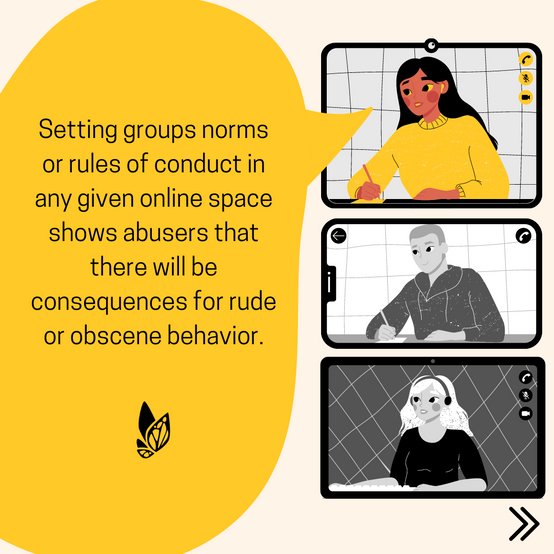Build safe online spaces to prevent cyber-violence
- WISE

- Apr 1, 2022
- 3 min read
Updated: Sep 7, 2022
In an increasingly digitized world, it's important for us to learn how to build safe online spaces that condemn cyberbullying and cyberstalking. This Sexual Assault Awareness Month (April 2022), we will focus on creating new norms and practices on digital consent, respecting boundaries in an online platform, and sharing safe ways to intervene in cyber-violence.
Download Center
Download our social media slides on 4 Ways to Practice Online Consent:
Download our social media slides on the importance of establishing group norms:
How does internet culture perpetuate cyberbullying?
The internet allows us to engage online anonymously or take on alternative identities. This encourages people to freely lash out or prey on others without bearing the consequences of their actions.
Example: Jessie creates a fake account and leaves nasty comments on a classmate’s Facebook page. When her account gets reported and suspended, she creates another one to do the same.
Our internet algorithm is designed to show us content that we have previously engaged in. This means that when we are on social media, we might only see news or conversations that are of topics we like and believe in. While this has its benefits, the algorithm is harmful in creating an illusion of agreement and prevents you from hearing from different viewpoints.
Example: On January 6, 2021, thousands of Trump supporters stormed the U.S. Capitol because they were convinced by the media that Trump should have won the election.
4 ways to practice online consent and change internet culture
In any online space, develop rules of conduct or group norms to ensure that everyone is on the same page and can participate to the best of their abilities. These can include rules for taking turns, an acknowledgement of different opinions, or setting a routine or agenda. This is also a good opportunity to review the functions of your meeting platform and integrate them into the rules of conduct (i.e., how to navigate functions on Zoom, Google Meet, etc.).
Give everyone the option of turning their camera on/off during a meeting; or set rules for when it is appropriate to turn the camera on/off. Building connections in online groups/meetings can be very challenging, especially if cameras are turned off and no one can see each other. This is a good opportunity to set rules for when cameras can be turned on/off. Additionally, it gives people a chance to turn their camera on/off if a meeting is being recorded.
Give everyone the option of sharing their personal pronouns. Personal pronouns are personal information and should be shared if you are comfortable. They can be shared verbally or on your onscreen name.
Before taking and posting a group photo online, make sure you have the consent of everyone in the photo to do so. Screenshot photos are easy to take and can be done without anyone noticing. Regardless, we should not take anyone's image without their consent.
How does developing group norms in an online space prevent online sexual assault, harassment, or abuse?
Setting groups norms or rules of conduct in any given online space shows abusers that there will be consequences for rude or obscene behavior.
Setting group norms indicate that everyone in the online space has agreed to abide by the rules they have created together. This promotes consent and respect for how the online space is managed.
Setting group norms encourages community-building and helps promote community-led action in taking down any forms of online harassment and abuse.
Be an active bystander to cyberbullying
Delegate: Report the bullying content to online administrators
Disengage: Don’t share the bullying content
Direct: Speak out when you see comments, images, or other media being used to bully others
Distract: Share other topics or pictures to take attention away from the bullying content


























Comments